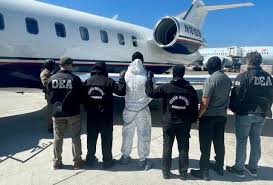The anatomy of a drug deal gone wrong

The Panamanian Jorge Rubén Camargo Clarke, who under the alias Cholo Chorrillo was allegedly one of the leaders of the Bagdad gang, is facing legal proceedings in Los Angeles for conspiring to import cocaine into the US.
His indictment reveals details of the operation of his organization, and the game of cat and mouse with the security forces in Panama says La Prensa.
The indictment is dated January 9, 2020, when it was presented to the federal grand jury for the central district of California. Camargo Clarke is the protagonist in a 5-page document, that does not mention another person by name. Prosecutors for the US Department of Justice identify Camargo Clarke by his aliases Cool Nene, El Nene and Nene.
The document indicates 13 facts that would prove the alleged participation of Camargo Clarke in the criminal organization. from October 2017 to May 2018.
According to the indictment, on October 13, 2017, Camargo Clarke contacted “co-conspirator 1”, to find out the prices of cocaine in Colombia. The court document emphasizes that Camargo Clarke used “encoded language in electronic communication” to make contact with the intention of sending the drug to the US and other countries.
On October 26, Camargo Clarke, using the same method, contacted co-conspirator 1 to inquire if he was ready to ship drugs to Panama. Then, on November 9, Camargo Clarke notifies the contact in Colombia that the shipment must be postponed due to the constant surveillance of the Panamanian security forces, on the route designed for the transport of the drug.
On November 13, co-conspirator 1 informed Camargo Clarke that he had already acquired the cocaine and was waiting for a quantity of marijuana to make the joint shipment to Panama. Prosecutors from the Department of Justice affirmed that on this same date and until November 15, Camargo Clarke organized, together with other co-conspirators, the transfer of drugs from Colombia to Panama.
On November 15, Camargo Clarke informs co-conspirator 1 that the route to transport the drug, from Colombia to Panama, was clear.
The next day, co-conspirator 1 informed Camargo Clarke that the shipment was ready to take place that day, and suggested that he not contact him on his phone to “avoid police detection.”
Between November 16 and 17, 2017, the other co-conspirators, close to Camargo Clarke, transported the drug to Panama. On November 17, Camargo Clarke notified co-conspirator 1 that the drug had arrived in Panama that morning.
On November 18, the destination of this shipment changed, since Camargo Clarke informed his co-conspirator 1 in Colombia that the Panamanian authorities had located the vessel that brought the drugs.
On November 21, Camargo Clarke shared the news, to the same addressee, that the Panamanian authorities had seized the cocaine and marijuana that they had trafficked from Colombia.
The document prepared by the US federal prosecutors indicates that on January 25 and 26, 2018, Camargo Clarke and co-conspirator 1 discussed a new shipment of cocaine. Then the document indicates that on May 30, 2018, Camargo Clarke and co-conspirator 1 met in Panama to discuss future cocaine shipments.
The milestones
Federal prosecutors explained that Camargo Clarke’s role was to bring the cocaine to Panama and take it to Costa Rica, from where other links would take it to the United States and other destinations.
Part of the facts described in the indictment is confirmed by the news of November 20, 2017, that the National Border Service seized 1,941 packages of cocaine and 61 packages of marijuana in Jaqué, Darién, together with a ship that was carrying the cargo whose crew fled towards the dense Darien jungle.
On February 11, 2022, Camargo Clarke, who had escaped from Panamanian justice, was arrested in Costa Rica at the request of US authorities.





